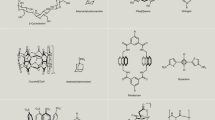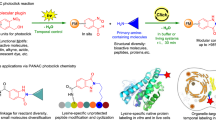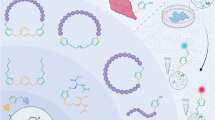Abstract
The coupling and decoupling of molecular units is a fundamental undertaking of organic chemistry. Herein we report the use of a very simple conjugate acceptor, derived from Meldrum's acid, for the sequential ‘clicking’ together of an amine and a thiol in aqueous conditions at neutral pH. Subsequently, this linkage can be ‘declicked’ by a chemical trigger to release the original amine and thiol undisturbed. The reactivity differs from that of other crosslinking agents because the selectivity for sequential functionalization derives from an altering of the electrophilicity of the conjugate acceptor on the addition of the amine. We describe the use of the procedure to modify proteins, create multicomponent libraries and synthesize oligomers, all of which can be declicked to their starting components in a controlled fashion when desired. Owing to the mild reaction conditions and ease of use in a variety of applications, the method is predicted to have wide utility.
This is a preview of subscription content, access via your institution
Access options
Subscribe to this journal
Receive 12 print issues and online access
$259.00 per year
only $21.58 per issue
Buy this article
- Purchase on Springer Link
- Instant access to full article PDF
Prices may be subject to local taxes which are calculated during checkout






Similar content being viewed by others
References
Kolb, H. C., Finn, M. G. & Sharpless, K. B. Click chemistry: diverse chemical function from a few good reactions. Angew. Chem. Int. Ed. 40, 2004–2021 (2001).
Hoyle, C. E. & Bowman, C. N. Thiol-ene click chemistry. Angew. Chem. Int. Ed. 49, 1540–1573 (2010).
Becer, C. R., Hoogenboom, R. & Schubert, U. S. Click chemistry beyond metal-catalyzed cycloaddition. Angew. Chem. Int. Ed. 48, 4900–4908 (2009).
Chmielewski, M. K. Protecting of a thermolabile protecting group: ‘click–clack’ approach. Org. Lett. 11, 3742–3745 (2009).
Baskin, J. M. et al. Copper-free click chemistry for dynamic in vivo imaging. Proc. Natl Acad. Sci. USA 104, 16793–16797 (2007).
Jewett, J. C., Sletten, E. M. & Bertozzi, C. R. Rapid Cu-free click chemistry with readily synthesized biarylazacyclooctynones. J. Am. Chem. Soc. 132, 3688–3690 (2010).
Chang, P. V. et al. Copper-free click chemistry in living animals. Proc. Natl Acad. Sci. USA 107, 1821–1826 (2010).
Huisgen, R. 1,3-Dipolar cycloadditions: past and future. Angew. Chem. Int. Ed. Engl. 2, 565–598 (1963).
Huisgen, R. 1,3-Dipolar cycloadditions. Proc. Chem. Soc. 357–396 (1961).
Huisgen, R. Kinetics and reaction mechanisms: selected examples from the experience of forty years. Pure Appl. Chem. 61, 613–628 (1989).
Kolb, H. C. & Sharpless, K. B. The growing impact of click chemistry on drug discovery. Drug Discov. Today 8, 1128–1137 (2003).
Moses, J. E. & Moorhouse, A. D. The growing applications of click chemistry. Chem. Soc. Rev. 36, 1249–1262 (2007).
Brantley, J. N., Konda, S. S. M., Makarov, D. E. & Bielawski, C. W. Regiochemical effects on molecular stability: a mechanochemical evaluation of 1,4- and 1,5-disubstituted triazoles. J. Am. Chem. Soc. 134, 9882–9885 (2012).
Cravotto, G. & Cintas, P. Harnessing mechanochemical effects with ultrasound-induced reactions. Chem. Sci. 3, 295–307 (2012).
Diels, O. & Alder, K. Synthesen in der hydroaromatischen Reihe. Ber. Dtsch. Chem. Ges. 62, 2337–2372 (1929).
Kwart, H. & King, K. The reverse Diels–Alder or retrodiene reaction. Chem. Rev. 68, 415–447 (1968).
Trost, B. M., Ippen, J. & Vladuchick, W. C. The regioselectivity of the catalyzed and uncatalyzed Diels–Alder reaction. J. Am. Chem. Soc. 99, 8116–8118 (1977).
Gandini, A. The furan/maleimide Diels–Alder reaction: a versatile click–unclick tool in macromolecular synthesis. Prog. Polym. Sci. 38, 1–29 (2013).
Meng, J.-C., Averbuj, C., Lewis, W. G., Siuzdak, G. & Finn, M. G. Cleavable linkers for porous silicon-based mass spectrometry. Angew. Chem. Int. Ed. 43, 1255–1260 (2004).
Boul, P. J., Reutenauer, P. & Lehn, J.-M. Reversible Diels–Alder reactions for the generation of dynamic combinatorial libraries. Org. Lett. 7, 15–18 (2005).
Hermanson, G. T. Bioconjugate Techniques (Academic, 2008).
Bielski, R. & Witczak, Z. Strategies for coupling molecular units if subsequent decoupling is required. Chem. Rev. 113, 2205–2243 (2013).
Best, M. D. Click chemistry and bioorthogonal reactions: unprecedented selectivity in the labeling of biological molecules. Biochemistry 48, 6571–6584 (2009).
Kalia, J. & Raines, R. T. Advances in bioconjugation. Curr. Org. Chem. 14, 138–147 (2010).
Canalle, L. A., Löwik, D. W. P. M. & van Hest, J. C. M. Polypeptide–polymer bioconjugates. Chem. Soc. Rev. 39, 329–353 (2010).
Ulrich, S., Boturyn, D., Marra, A., Renaudet, O. & Dumy, P. Oxime ligation: a chemoselective click-type reaction for accessing multifunctional biomolecular constructs. Chemistry 20, 34–41 (2014).
Otto, S., Furlan, R. L. E. & Sanders, J. K. M. Selection and amplification of hosts from dynamic combinatorial libraries of macrocyclic disulfides. Science 297, 590–593 (2002).
Shi, B. & Greaney, M. F. Reversible Michael addition of thiols as a new tool for dynamic combinatorial chemistry. Chem. Commun. 886–888 (2005).
Corbett, P. T. et al. Dynamic combinatorial chemistry. Chem. Rev. 106, 3652–3711 (2006).
Lehn, J.-M. Chemistry: dynamic combinatorial chemistry. Science 291, 2331–2332 (2001).
Joshi, G. & Anslyn, E. V. Dynamic thiol exchange with β-sulfido-α,β-unsaturated carbonyl compounds and dithianes. Org. Lett. 14, 4714–4717 (2012).
Zhong, Y., Xu, Y. & Anslyn, E. V. Studies of reversible conjugate additions. Eur. J. Org. Chem. 2013, 5017–5021 (2013).
Shi, B., Stevenson, R., Campopiano, D. J. & Greaney, M. F. Discovery of glutathione S-transferase inhibitors using dynamic combinatorial chemistry. J. Am. Chem. Soc. 128, 8459–8467 (2006).
Lo, W.-J. et al. Enzymatic and nonenzymatic synthesis of glutathione conjugates: application to the understanding of a parasite's defense system and alternative to the discovery of potent glutathione S-transferase inhibitors. Bioconjug. Chem. 18, 109–120 (2007).
Rim, C., Lahey, L. J., Patel, V. G., Zhang, H. & Son, D. Y. Thiol-ene reactions of 1,3,5-triacryloylhexahydro-1,3,5-triazine (TAT): facile access to functional tripodal thioethers. Tetrahedron Lett. 50, 745–747 (2009).
Mather, B. D., Viswanathan, K., Miller, K. M. & Long, T. E. Michael addition reactions in macromolecular design for emerging technologies. Prog. Polym. Sci. 31, 487–531 (2006).
Ben Cheikh, A. et al. Synthesis of α-cyano carbonyl compounds by flash vacuum thermolysis of (alkylamino)methylene derivatives of Meldrum's acid. Evidence for facile 1,3-shifts of alkylamino and alkylthio groups in imidoylketene intermediates. J. Org. Chem. 56, 970–975 (1991).
Huang, X. & Chen, B.-C. Synthesis of bisalkylthiolydine derivatives of Meldrum's acid and barbituric acid. Synthesis 967–968 (1986).
Ye, F.-C., Chen, B.-C. & Huang, X. Synthesis of 7-substituted 5-oxo-5H-thiazolo[3,2-a]pyrimidine-6-carboxylic acids, 2-substituted 4-oxo-4H-pyrido[1,2-a]pyrimidine-3-carboxylic acids, and 2,6-disubstituted 4-quinolones from Meldrum's acid derivatives. Synthesis 317–320 (1989).
Christie, R. J., Anderson, D. J. & Grainger, D. W. Comparison of hydrazone heterobifunctional cross-linking agents for reversible conjugation of thiol-containing chemistry. Bioconjug. Chem. 21, 1779–1787 (2010).
Højfeldt, J. W., Blakskjaer, P. & Gothelf, K. V. A cleavable amino-thiol linker for reversible linking of amines to DNA. J. Org. Chem. 71, 9556–9559 (2006).
Dawson, P., Muir, T., Clark-Lewis, I. & Kent, S. Synthesis of proteins by native chemical ligation. Science 266, 776–779 (1994).
Canne, L. E., Bark, S. J. & Kent, S. B. H. Extending the applicability of native chemical ligation. J. Am. Chem. Soc. 118, 5891–5896 (1996).
Otto, S., Furlan, R. L. & Sanders, J. K. Dynamic combinatorial chemistry. Drug Discov. Today 7, 117–125 (2002).
Liang, R. et al. Polyvalent binding to carbohydrates immobilized on an insoluble resin. Proc. Natl Acad. Sci. USA 94, 10554–10559 (1997).
McNaughton, B. R. & Miller, B. L. Resin-bound dynamic combinatorial chemistry. Org. Lett. 8, 1803–1806 (2006).
Raju, B. & Kogan, T. P. Use of halomethyl resins to immobilize amines: an efficient method for synthesis of sulfonamides and amides on a solid support. Tetrahedron Lett. 38, 4965–4968 (1997).
Veronese, F. M. Peptide and protein PEGylation. Biomaterials 22, 405–417 (2001).
Roberts, M. J., Bentley, M. D. & Harris, J. M. Chemistry for peptide and protein PEGylation. Adv. Drug Deliv. Rev. 64, 116–127 (2012).
Schumacher, F. F. et al. In situ maleimide bridging of disulfides and a new approach to protein PEGylation. Bioconjug. Chem. 22, 132–136 (2011).
Acknowledgements
We acknowledge financial support from the Defense Advanced Research Projects Agency (N66001-14-2-4051 to E.V.A.), the National Science Foundation (CHE-1212971 to E.V.A.; CHE1402753 to J.S.B.), Welch Regents Chair (F-0046 to E.V.A.) and the Welch Foundation (F-1155 to J.S.B.).
Author information
Authors and Affiliations
Contributions
K.L.D. helped conceive and design the experiments, performed them and analysed the data, and wrote the first draft of the paper. I.V.K. also helped conceive and design experiments, carried them out and analysed the data, and edited the paper. S.A.R. analysed synthesized compounds using mass spectrometry. J.L.B. helped synthesize starting materials for experiments performed herein. Y.Z. performed preliminary experiments that demonstrated the utility of the Meldrum's acid conjugate acceptor 1. J.S.B. contributed analysis tools and E.V.A. conceived and/or designed experiments and edited the paper.
Corresponding author
Ethics declarations
Competing interests
The authors declare no competing financial interests.
Supplementary information
Supplementary information
Supplementary information (PDF 9554 kb)
Rights and permissions
About this article
Cite this article
Diehl, K., Kolesnichenko, I., Robotham, S. et al. Click and chemically triggered declick reactions through reversible amine and thiol coupling via a conjugate acceptor. Nature Chem 8, 968–973 (2016). https://doi.org/10.1038/nchem.2601
Received:
Accepted:
Published:
Issue Date:
DOI: https://doi.org/10.1038/nchem.2601
This article is cited by
-
Photoswitchable dynamic conjugate addition-elimination reactions as a tool for light-mediated click and clip chemistry
Nature Communications (2023)
-
Bioinspired one-pot furan-thiol-amine multicomponent reaction for making heterocycles and its applications
Nature Communications (2023)
-
Chemically triggered life control of “smart” hydrogels through click and declick reactions
Frontiers of Chemical Science and Engineering (2022)
-
Bioorthogonal chemistry
Nature Reviews Methods Primers (2021)
-
Click chemistry enables quantitative chiroptical sensing of chiral compounds in protic media and complex mixtures
Nature Communications (2018)



